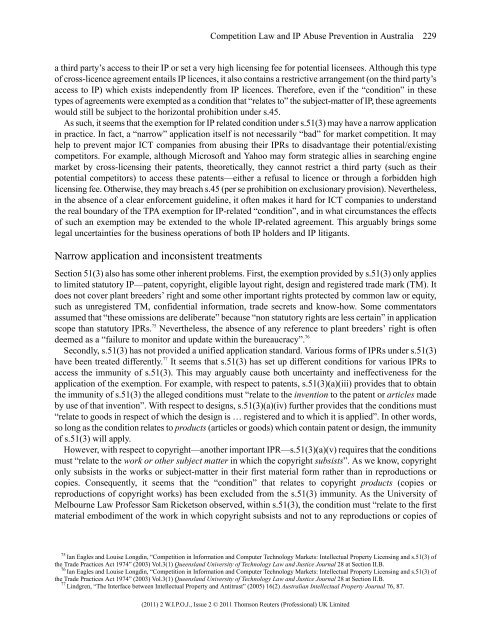WIPO Journal - World Intellectual Property Organization
WIPO Journal - World Intellectual Property Organization
WIPO Journal - World Intellectual Property Organization
You also want an ePaper? Increase the reach of your titles
YUMPU automatically turns print PDFs into web optimized ePapers that Google loves.
a third party’s access to their IP or set a very high licensing fee for potential licensees. Although this type<br />
of cross-licence agreement entails IP licences, it also contains a restrictive arrangement (on the third party’s<br />
access to IP) which exists independently from IP licences. Therefore, even if the “condition” in these<br />
types of agreements were exempted as a condition that “relates to” the subject-matter of IP, these agreements<br />
would still be subject to the horizontal prohibition under s.45.<br />
As such, it seems that the exemption for IP related condition under s.51(3) may have a narrow application<br />
in practice. In fact, a “narrow” application itself is not necessarily “bad” for market competition. It may<br />
help to prevent major ICT companies from abusing their IPRs to disadvantage their potential/existing<br />
competitors. For example, although Microsoft and Yahoo may form strategic allies in searching engine<br />
market by cross-licensing their patents, theoretically, they cannot restrict a third party (such as their<br />
potential competitors) to access these patents—either a refusal to licence or through a forbidden high<br />
licensing fee. Otherwise, they may breach s.45 (per se prohibition on exclusionary provision). Nevertheless,<br />
in the absence of a clear enforcement guideline, it often makes it hard for ICT companies to understand<br />
the real boundary of the TPA exemption for IP-related “condition”, and in what circumstances the effects<br />
of such an exemption may be extended to the whole IP-related agreement. This arguably brings some<br />
legal uncertainties for the business operations of both IP holders and IP litigants.<br />
Narrow application and inconsistent treatments<br />
Competition Law and IP Abuse Prevention in Australia 229<br />
Section 51(3) also has some other inherent problems. First, the exemption provided by s.51(3) only applies<br />
to limited statutory IP—patent, copyright, eligible layout right, design and registered trade mark (TM). It<br />
does not cover plant breeders’ right and some other important rights protected by common law or equity,<br />
such as unregistered TM, confidential information, trade secrets and know-how. Some commentators<br />
assumed that “these omissions are deliberate” because “non statutory rights are less certain” in application<br />
scope than statutory IPRs. 75 Nevertheless, the absence of any reference to plant breeders’ right is often<br />
deemed as a “failure to monitor and update within the bureaucracy”. 76<br />
Secondly, s.51(3) has not provided a unified application standard. Various forms of IPRs under s.51(3)<br />
have been treated differently. 77 It seems that s.51(3) has set up different conditions for various IPRs to<br />
access the immunity of s.51(3). This may arguably cause both uncertainty and ineffectiveness for the<br />
application of the exemption. For example, with respect to patents, s.51(3)(a)(iii) provides that to obtain<br />
the immunity of s.51(3) the alleged conditions must “relate to the invention to the patent or articles made<br />
by use of that invention”. With respect to designs, s.51(3)(a)(iv) further provides that the conditions must<br />
“relate to goods in respect of which the design is … registered and to which it is applied”. In other words,<br />
so long as the condition relates to products (articles or goods) which contain patent or design, the immunity<br />
of s.51(3) will apply.<br />
However, with respect to copyright—another important IPR—s.51(3)(a)(v) requires that the conditions<br />
must “relate to the work or other subject matter in which the copyright subsists”. As we know, copyright<br />
only subsists in the works or subject-matter in their first material form rather than in reproductions or<br />
copies. Consequently, it seems that the “condition” that relates to copyright products (copies or<br />
reproductions of copyright works) has been excluded from the s.51(3) immunity. As the University of<br />
Melbourne Law Professor Sam Ricketson observed, within s.51(3), the condition must “relate to the first<br />
material embodiment of the work in which copyright subsists and not to any reproductions or copies of<br />
75 Ian Eagles and Louise Longdin, “Competition in Information and Computer Technology Markets: <strong>Intellectual</strong> <strong>Property</strong> Licensing and s.51(3) of<br />
the Trade Practices Act 1974” (2003) Vol.3(1) Queensland University of Technology Law and Justice <strong>Journal</strong> 28 at Section II.B.<br />
76 Ian Eagles and Louise Longdin, “Competition in Information and Computer Technology Markets: <strong>Intellectual</strong> <strong>Property</strong> Licensing and s.51(3) of<br />
the Trade Practices Act 1974” (2003) Vol.3(1) Queensland University of Technology Law and Justice <strong>Journal</strong> 28 at Section II.B.<br />
77 Lindgren, “The Interface between <strong>Intellectual</strong> <strong>Property</strong> and Antitrust” (2005) 16(2) Australian <strong>Intellectual</strong> <strong>Property</strong> <strong>Journal</strong> 76, 87.<br />
(2011) 2 W.I.P.O.J., Issue 2 © 2011 Thomson Reuters (Professional) UK Limited

















